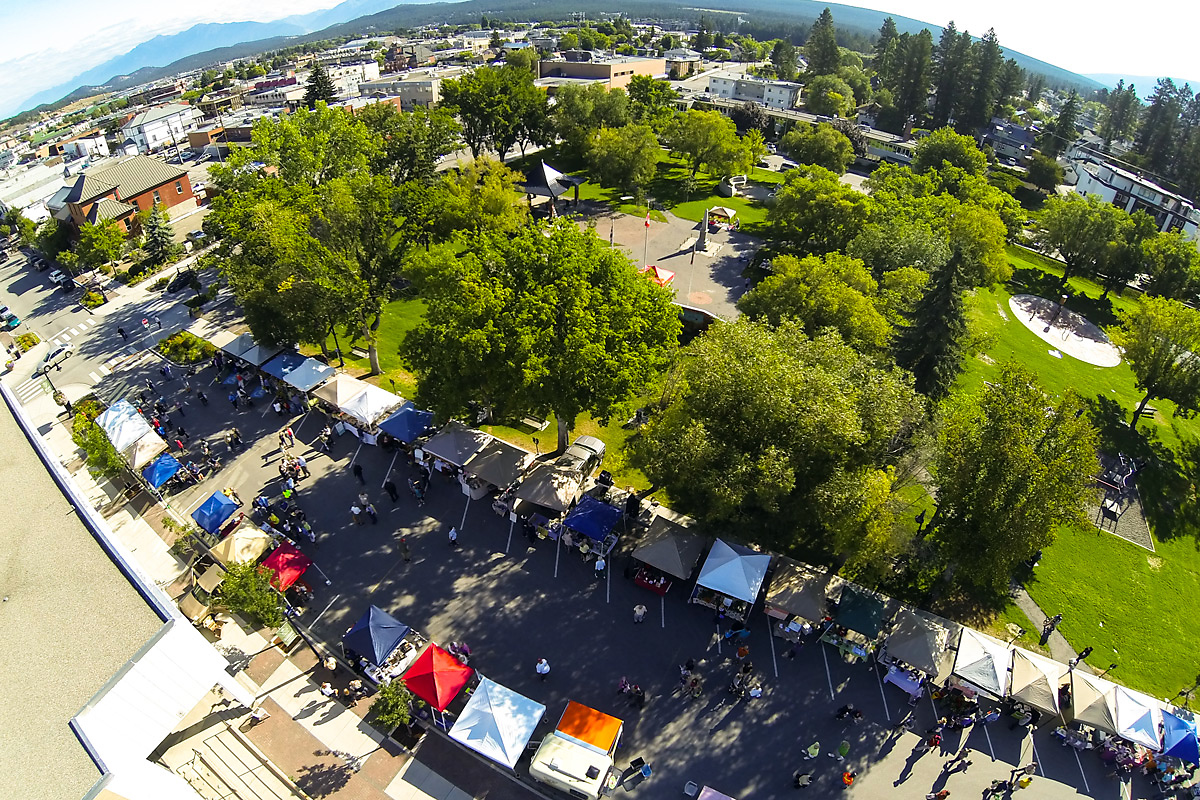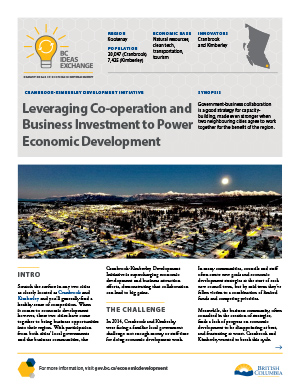Leveraging Co-operation and Business Investment to Power Economic Development
Cranbrook & Kimberley
Scratch the surface in any two cities as closely located as Cranbrook and Kimberley and you’ll generally find a healthy sense of competition. When it comes to economic development however, these two cities have come together to bring business opportunities into their region. With participation from both cities’ local governments and the business communities, the Cranbrook-Kimberley Development Initiative is supercharging economic development and business attraction efforts, demonstrating that collaboration can lead to big gains.
The Challenge

In 2014, Cranbrook and Kimberley were facing a familiar local government challenge: not enough money or staff time for doing economic development work. In many communities, councils and staff often create new goals and economic development strategies at the start of each new council term, but by mid term they’ve fallen victim to a combination of limited funds and competing priorities.
Meanwhile, the business community, often consulted in the creation of strategies, finds a lack of progress on economic development to be disappointing at best, and frustrating at worst. Cranbrook and Kimberley wanted to break this cycle.
The Strategy
In 2014, the newly elected mayors of Cranbrook and Kimberley came together with their business communities to develop a model of regional collaboration to overcome the typical resource barriers faced in smaller centres.
Only 28 km apart, the two cities have long shared a healthy and fun rivalry, but the mayors and councils also recognized there were many linkages between their communities. “Cranbrook and Kimberley are so complementary. It just makes sense for us to get together around economic development,” says Don McCormick, mayor of Kimberley.
Lee Pratt, mayor of Cranbrook, and McCormick took it one step further, proposing to combine economic development funds to market their region, and for both mayors to be the “salesmen” for their communities. As Pratt points out, “who better to sell a city than your mayor?”

Funds are tight in small communities though, and even on the combined budget of $20,000, the mayors felt it would be hard to make enough of a splash. An idea began to develop based on a model from Cranbrook’s sister city, Coeur d’Alene, Idaho, where its economic development agency used a combination of business investment and municipal funds to aggressively market the region to out-of-state businesses, encouraging companies to expand or relocate to the Coeur d’Alene area.
Rick Jensen, a former mayor of Cranbrook (1984-1990) and a local businessman, suggested following this model: get the business community to contribute funds and seek matching funding from other agencies. With more funding and the strength of collaboration, a marketing campaign for the region could generate many more leads for the mayors, acting together, to connect with businesses looking for a place to locate.
Jensen, McCormick and Pratt called a public meeting of the business community, and convinced 46 businesses to invest $5,000 each. The Columbia Basin Trust eagerly matched the funding, and each of the cities put forward money and staff support, with the Regional District of East Kootenay contributing funds as well. The product of this combined effort and resources was the Cranbrook-Kimberley Development Initiative (CKDI).
CKDI operates as a non-profit society with a volunteer board of directors. The mayors of each city attend board meetings but are not voting members. CKDI doesn’t have any paid staff, but the volunteer board and other engaged business leaders (including the Chamber of Commerce membership) work together in partnership with city staff to move economic development forward in the region.
Successes
The CKDI worked with consultants to research industry sectors that could be targeted, and to write a plan to attract businesses to the region. The volunteer board developed a powerful marketing campaign and social media presence, supported by a community profile showcasing both cities. A new website emphasizes the quality of life that the Cranbrook-Kimberley area offers, as well as the excellent transportation linkages and educated workforce.
The mayors provide leadership and act as spokespeople for the region, speaking to companies about the benefits of locating to B.C., and their cities in particular. While everyone involved hoped to see big results right away, they’ve learned to be patient, as successful strategies take time to develop and implement. CKDI is now halfway through its three-year strategic plan implementation and has already learned a great deal about cross-regional, business-government collaboration.
Lessons Learned
- Encourage your business community to get involved in economic development, and don’t expect that the municipal government has the resources or connections to succeed on their own.
- Joint initiatives need a lot of communication so everyone feels informed and involved.
- Before launching a campaign to promote your community as investment-ready, make sure that you have land available and zoned appropriately, and that your municipal processes are streamlined. “Be ready for the fish when you catch it,” says Kimberley Mayor Don McCormick.
- Be patient and manage expectations about how quickly a marketing campaign can be launched and see results – it takes energy and time to turn leads into business openings.
The Cranbrook-Kimberley Development Initiative (CKDI) is a non-profit society that was formed by local business leaders, the mayors and key municipal staff to present our region as one economic zone.



